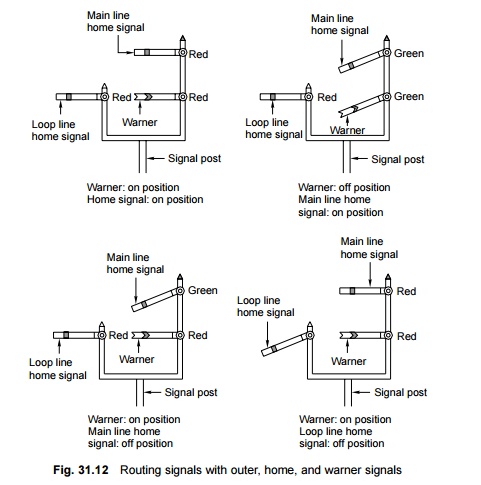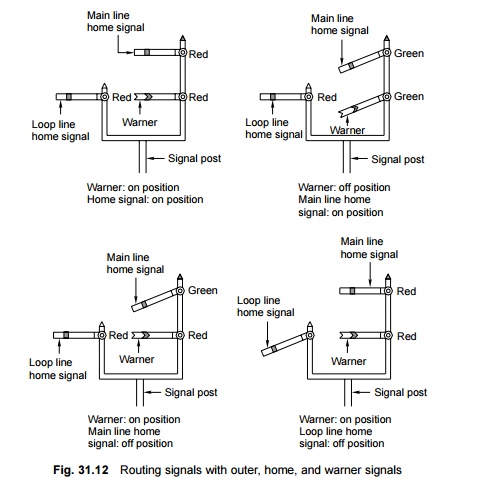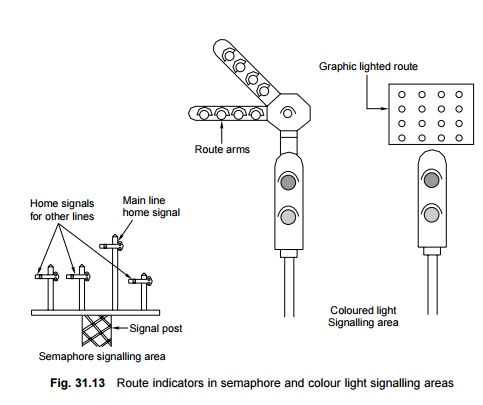Chapter: Civil : Railway Airport Harbour Engineering : Railway Engineering : Signalling and Interlocking
Types of Stop Signals used on railways

Stop Signals
The various types of signals with
reference to their location on a station are discussed in detail below.
Outer signal
This is the first stop signal at
a station, which indicates the entry of a train from a block section into the
station limits. This signal is provided at an adequate distance beyond the
station limits so that the line is not obstructed once the permission to
approach has been given. It is provided at a distance of about 580 m from the
home signal. The signal has one arm but has a warner signal nearly 2 m below on
the same post.
When the outer signal is in the
'on' (or stop) position, it indicates that the driver must bring the train to a
stop at a distance of about 9 m from the signal and then proceed with caution
towards the home signal. If the outer signal is in the 'off' (or proceed)
position, it indicates that the driver does not need to reduce the speed of the
train if the home signal is also in the 'off' (or proceed) position, which is
indicated by the 'off' position of the warner.
As the outer signal controls the
reception of trains, it comes under the category of reception signals.
Home signal
After the outer signal, the next
stop signal towards the station side is a home signal. It is provided right at
the entrance of the station for the protection of the station limits. The
signal is provided about 190 m short of the points and crossings. The arms
provided on a home signal are generally as many as the number of reception
lines in the station yard.
When a home signal is in the 'on' (or stop)
position it indicates that the train must come to a halt short of the signal.
In the 'off' (or proceed) position, it indicates that the particular line is
free and the train is permitted to enter cautiously.
The home
signal also comes in the category of reception signals.
Routing signal
The various signals fixed on the
same vertical post for both main and branch lines are known as routing signals.
These signals indicate the route that has been earmarked for the reception of
the train. Generally the signal for the main line is kept at a higher level
than that for the loop line. It is necessary for the driver of a train
approaching a reception signal to know the line on which his or her train is
likely to be received so that he or she can regulate the speed of the train
accordingly. In case the train is being received on the loop line, the speed
has to be restricted to about 15 km/h, whereas if the reception is on the main
line a higher speed is permissible. The various positions of the routing signal
for a station with an outer signal, a home signal, and a warner signal that is
provided below the outer signal are shown in Fig. 31.12.

Route indicators can also be
provided by including separate home signals for each line, with the main line
home signal being placed the highest while all the other signals are placed at
the same level.
In the case of coloured light
signals, the home signal is provided with either a graphic lighted route
indicator displaying the line number on which the train is to be received or
different arms lighted by five lamps. These lamps form the arm, which is used
for indicating a line, while there is no arm in the case of a main line as
depicted in Fig. 31.13.

Starter signal
The starter signal is a stop
signal and marks the limit up to which a particular line can be occupied
without infringing on other lines. A separate starter signal is provided for
each line. The starter signal controls the movement of the train when it
departs from the station. The train leaves the station only when the starter
signal is in the 'off' (or proceed) position. As this signal controls the
departure of a train, it comes under the category of departure signals.
Advanced starter signal
This is the last stop signal
provided for the departure of trains from a station. The signal is provided
about 180 m beyond the outermost points or switches and marks the end of the
station limits. A block section lies between the advanced starter signal of one
station and the outer signal of the next station. No train can leave the
station limits until and unless the advance starter is lowered.
Related Topics